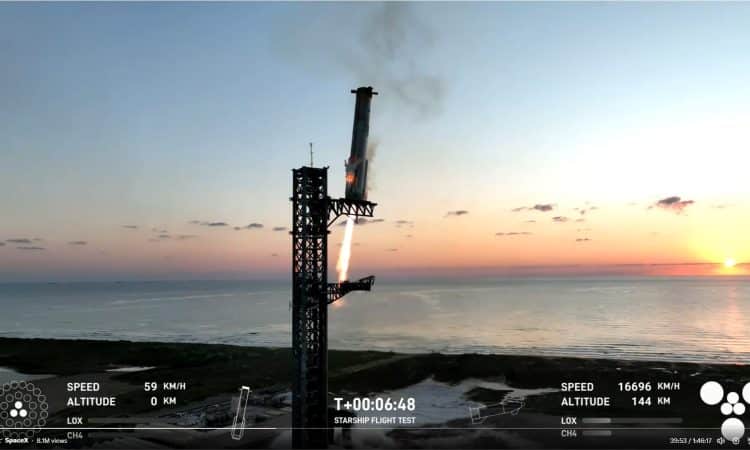
For the first time, SpaceX was able to precisely catch the Starship booster, called Super Heavy, after a test launch using the “Mechazilla” arms, the special system on the launch tower in Texas. “This is a day for the engineering history books,” said SpaceX launch commentator Kate Tice.
This achievement marks an important step towards the use and reuse of the Starship for various missions, from satellite launches to NASA missions to the Moon and eventually colonization missions to Mars.
it occurred minutes after the Super Heavy launched the craft’s second stage, known as the Ship, into space during the system’s fifth test flight. The launch took place on October 13, at 15:25 (Romanian time), from the SpaceX base in southern Texas.
Although the primary objective of the test was for the Ship to survive atmospheric re-entry and land intact in the Indian Ocean, the Super Heavy was the star of the day.
Starship booster caught in flight at SpaceX base
The Super Heavy is not designed to land on its feet, as the Falcon 9 rocket does. Instead, SpaceX opted for a ground attachment system to maximize the payload capacity of the booster and minimize the time required for reuse. Perfecting Mechazilla capture is thus central to SpaceX’s rapid rocket reuse strategy.
Source: YouTube
This success required extreme precision during the propellant’s autonomous descent through the atmosphere. The Super Heavy had to position itself precisely between Mechazilla’s adjustable arms, also known as “Chinese chopsticks”, and remain suspended while the mechanism was activated to secure the missile.
If something had gone wrong, the thruster would have been redirected to the Gulf of Mexico. Fortunately, everything went perfectly.
“Even in this modern era, what we saw looks like magic,” said commentator Dan Huot after the Starship booster shut down its engines and clung to the launch tower.
What tests was SpaceX’s Starship rocket subjected to?
Today’s test of Starship, the world’s most powerful rocket, went according to plan from launch to landing. All 33 methane-fueled Raptor engines fired for the launch, and 13 of them ensured the return of the Super Heavy propellant to the platform. The second stage continued at orbital speeds, on a suborbital trajectory, reaching an altitude of about 200 kilometers. An hour after launch, Ship restarted three of its Raptor engines and made an autonomous descent to the designated landing point in the Indian Ocean, .
During Starship’s fourth test flight in June, Ship suffered damage but survived the landing. Its thermal protection system has been improved for the recent test.
Video footage transmitted via SpaceX’s Starlink satellite network showed heat build-up on the craft’s control surfaces. Sparks were seen during the descent, but the flaps eventually cooled, drawing applause from SpaceX employees watching the broadcast.
Minutes later, the missile’s video feed showed Ship making a vertical descent into the water, and a different video feed from a nearby buoy showed the ship floating on the water’s surface.
“What an incredible end to the Starship journey,” said Tice.
The Starship booster could soon take us to the Moon and Mars
The founder of SpaceX, , welcomed the results on his social platform, X (formerly Twitter): “The ship landed right on target! The second of the two objectives has been achieved,” he wrote.
Data from the test flight will be used to refine the launch system for future tests, using Starship hardware already prepared at Starbase. Ultimately, SpaceX aims to make the entire system fully reusable.
“I just caught a booster. Very soon we will start thinking about when we can catch a Ship as well,” said Huot. Starship could be used to speed up the deployment of Starlink satellites and perhaps even travel between terrestrial destinations.
NASA is relying on SpaceX to provide a modified version of the Starship that will serve as the landing module for manned Artemis missions starting in 2026.
“As we prepare to return to the Moon with Artemis, continued testing will prepare us for the bold missions ahead, including to the Moon’s South Pole region and beyond to Mars,” NASA Administrator Bill Nelson said in a congratulatory message posted on X.
SpaceX plans to use Starship for missions to Mars, starting with unmanned flights that could happen as early as 2026 and continuing with manned flights that could bring permanent residents to the Red Planet. Musk has said he envisions building a city on Mars by the 2040s, and Starship is key to that dream.
“Today we took a big step toward making humans a multiplanetary species,” Musk wrote on X.

